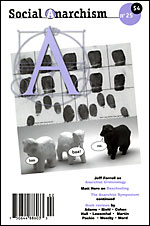Rain Without Thunder: The Ideology of the Animal Rights Movement
Rain Without Thunder: The Ideology of the Animal Rights Movement by Gary Francione. Philadelphia, PA: Temple University Press, 1996. $19.95 paper.
This book is an argument supporting the radical 'wing' of the animal rights movement. In this review I will lay out the skeleton of the author's argument, and follow this with a few summary remarks. I will be brief. The alternative would be a full-scale — and necessarily lengthy — treatment, and I have decided not to get into this. I limit myself to discharging only the reviewer's first and basic responsibility, to inform potential readers (and buyers) in such fashion that they can make informed decisions to read and/or purchase, eschewing the expanded form of the review essay.
The logic of Francione's argument is as follows:
- The fundamental fact regarding the disposition of animals at least in western societies is that they are the property of humans. This leads to a massive array of exploitative practices, in vivisection and other procedures in experimental science, in food production, and in a host of other activities mainly in entertainment, all of which are carried out within the institutional status of property law.
- The opposition to mistreatment has two wings, welfarist and rightist. Both claim to work toward the eventual abolition of all forms of animal exploitation. The welfarist theory (most importantly, the utilitarianism of Peter Singer) maintains that this goal can be achieved by incrementalist reform, and indeed, that some such reforms have in fact been achieved. The theory of animal rights , as developed first by Tom Regan in particular (and now Francione), maintains that the goal of abolition cannot be achieved through reform, but necessarily entails principled across-the-board rejection of all exploitative institutional practices, and that this requires abolition of the property status of animals. Francione presents an extensive and detailed analysis and critique of the utilitarianism on which welfarist theory is grounded.
- The reality of the welfarist movement in action confounds this basic theoretical difference. In the past the movement (which can be traced back over two centuries) was 'welfarist' in its actions seeking incremental protections for animals and in employing a discourse framed quite strictly by the property framework. The more recent animal rights movement, or at least the branch of which Francione may be taken to be representative, challenges this limitation, maintaining that any serious understanding of 'rights' requires change in the legal status of animals. However, the relation of theory to action has become muddled and confused, mainly because many of those whose incremental reformist claims and actions identify them as actual welfarists (i.e; 'new welfarists') have appropriated the rhetoric of rights discourse without recognizing that these reformist activities are not progress toward, but an obstacle to reaching the goal of abolition. Francione takes as his main task setting movement activists straight on this confounding of theorizing and forming of movement goals, and their proper relation to action.
- Empirically, the condition of the movement is one in which new welfarists in a variety of ways are found to be 'sleeping with the enemy': food producers, experimental scientists, government agencies and regulators, and others. Francione claims that, while routinely claiming abolition of the property status of animals as the movement goal, welfarists continue to demand and seek incremental legal reforms that in no way ever challenge the property status of animals. For example, they seek and sometimes achieve, minor improvements in the conditions under which experimental animals are held, and in the procedures to which they are subjected, but always in the framework of property. Their compromising of the principle of animal rights is transparent in many aspects of their discourse and action, in notions such as 'humane slaughter,' and development of a rational pain meter. Through the recounting of a set of cases, he claims to show that reforms not only fail to advance the movement agenda toward the goal of abolition, but (in many instances, at least) actually contribute to maintaining and strengthening institutional exploitation.
Francione then sets out to prove that neither of what he takes to be the two most important theoretical claims of the new welfarists — (1) that amelioration of the plight of animals can lead to abolition of exploitation, and (2) that animal rights cannot provide a theory of incremental reform leading to abolition — can be defended.
(a) He rejects the first of these on both empirical and theoretical grounds. Empirically, he argues — although without systematic analysis, it must be said — that reformers are forced to become 'insiders,' and so end up taking positions scarcely different from those of the exploiters. Theoretically, he argues that reformism in its nature presupposes the legitimacy of the property status of animals, an inherent denial of elemental physical security which exploiters will never relinquish through the avenues of normal pluralist politics.
(b) Regarding the second, he argues that the animal rights movement differs from almost all other movements (at least in democratic polities: Francione is not entirely clear on this point) excepting the movement to abolish slavery. The common element of property implies that, unlike other movements (in democratic polities) the goal must necessarily be the complete abolition of property status. The movement therefore has special requirements for action that set it off from all other movements. (i.e; reform movements). He proposes a chapter-length set of criteria for movement actions that — formally, at least — would exclude all actions not consistent with the movement goal of abolishing the property status of animals.
Rain Without Thunder is basically an exercise in moral philosophy and the limits and possibilities of action. Although it incorporates a good deal of historical fact, it is only secondarily a work of social science. I think that most readers will find it powerfully argued and convincing. Those with some knowledge of the workings of other movements, will find illuminating parallels, even though Francione eschews such discussions entirely. While it is only fair to keep in mind that he is a legal scholar and not a social scientist, it should also be said that his political analysis could have benefitted from an infusion of some up-to-date political and social movement theory.
Although Francione is clearly no anarchist, and despite the limitations of his political analysis, I think readers of SA would find much here that is stimulating and informative.

